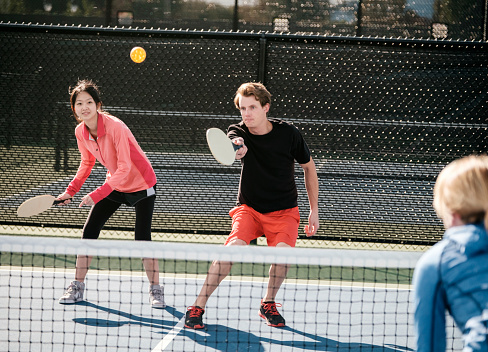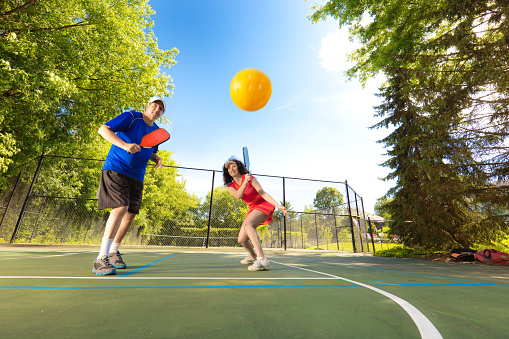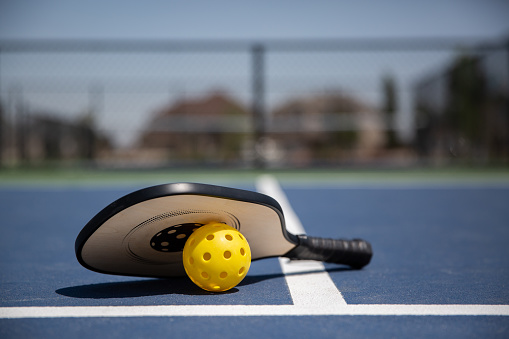main
How Long Do Pickleball Paddles Last
The pickleball paddle gets used for playing one of the most popular and fastest-growing sports globally. With time the pickleball equipment, especially the pickleball racquet, gets worn out and needs to get replaced.
The guide will let you know how long the pickleball paddles last. Apart from this, you will also learn to look for signs that indicate when to replace the paddle.
How Long Do Pickleball Paddles Last?
The lifespan of a pickleball paddle varies depending on several factors. It includes the quality of materials, frequency, level of care and maintenance, and the game’s intensity. A well-maintained pickleball paddle lasts about 2 to 5 years of regular use.
Good quality paddles get made from graphite, composite or fiberglass. These materials resist wear and tear and have better shock absorption, resulting in a longer lifespan.
When to Replace Your Paddle
You should replace your pickleball gear when it shows signs of wear and tear. Here are some telltale signs which indicate it’s time to replace your paddle:
Chips or Cracks – If you notice cracks or chips on the surface of the paddle will affect the paddle’s performance. It might cause the pickleball paddle to break during play.
Dents or Warping: Dents or warping will result in the paddle losing shape. It impacts your shots and makes them less accurate.
Delamination: Delamination occurs when the layers of a composite paddle start separating. The paddle loses its rigidity. It makes it less effective during play.
Loose Grip: When the grip on the paddle gets worn out or becomes loose, it affects your ability to hold it. If you can hold the paddle properly, it becomes easier to control the shots.
How to Prolong the Life of Your Pickleball Paddle

Here are the top 5 tips on how to maintain your paddle and extend its lifespan:
Tip 1: Maintain the Grip
Maintaining the grip of a pickleball paddle is essential for both comfort and control during play. After playing, use a damp cloth to wipe down the paddle’s grip. It removes any sweat, dirt, or debris accumulated during play.
With time the grip of a pickleball paddle wears down or becomes slick. After cleaning the grip, ensure it is completely dry before storing the paddle. A wet grip leads to slippage during play. Rotate the paddle grip regularly so the same area doesn’t get used every time you play.
If you find the grip of the pickleball racquet becoming slick, use grip enhancers (grip spray, grip wax, or grip powder). The grip enhancers provide extra traction and ensure a firm grip on your paddle.
Tip 2: Clinking is Bad
Avoid hitting hard surfaces with a pickleball paddle. Hitting the paddle on hard surfaces (ground or the net) will damage the paddle. Be careful when setting the paddle down or placing it in your bag.
When the paddle hits a hard surface, it results in dents or bumps in the surface of the paddle. Clinking results in layers of composite paddles separating or delaminating.
The edge guard of a paddle gets designed to protect the paddle from damage. The paddle is vulnerable to further damage without the protection of the edge guard. Clinking results in the edge guard cracking or becoming loose.
Many paddle manufacturers have specific guidelines on caring for and maintaining their paddles. Clinking voids the warranty and makes getting a replacement paddle if needed difficult.
Tip 3: Regularly Clean Up Your Paddle
After each use of the pickleball racquet, wipe it down with a damp cloth. It helps remove dirt, sweat or debris. It also prevents buildup and keeps the surface of the paddle in good condition.
Avoid using abrasive materials and harsh chemicals when cleaning. The use of chemicals damages the surface. Please don’t submerge the paddle in the water, as this can damage its surface. Instead, you can use mild soap and water for cleaning.
Tip 4: Storage Matters
Store the pickleball rackets in a cool, dry place when not used. Always store them in an area with stable room temperature. Keep them away from direct sunlight and extreme temperatures.
Avoid storing it in a car trunk and exposure to high temperatures. A protective cover prevents scratches, chips, and other damage to your paddle during transport and storage.
Tip 5: Play Smart and Right
If you play frequently, consider rotating between two paddles. It distributes the wear and tear evenly and prolongs the lifespan of both paddles.
The other aspect that determines the life of the pickleball paddle is your playing style. If you play aggressively, the paddle undergoes immense strain, affecting its durability.
Avoid overusing the pickleball gear, and always try to play smart and right so that the paddle lasts longer and gives you value for money.
Does it Matter What My Pickleball Paddle Gets Made From?
The material your pickleball paddle gets made from can affect its performance, durability, and feel. Wood paddles are the most affordable but offer less power and consistency.
Composite paddles are durable and provide reasonable control and consistency. Graphite paddles are lightweight and robust and provide a faster, more precise game. Aluminum paddles are also lightweight and durable.
- Graphite Surface Paddle
Graphite is a stiff and incredibly rigid material. A pickleball paddle made from this material is the lightest you will encounter.
- Carbon Fiber Surface Paddle
Carbon fiber is similar to graphite and is light and rigid. Even though it is lightweight, it provides excellent strength when you play the shots.
- Fiberglass Paddles
Most players tend to use pickleball rackets made from fiberglass. Lightweight and durable, the paddle lasts long.
- Hybrid Paddles
A combination of materials gets used to manufacturing hybrid paddles. The mix of materials makes the racquet solid and long-lasting.
Consider your playing style, level, and budget when choosing pickleball equipment.
What Are the Signs that Indicate a Pickleball Paddle Has Got Worn Out?
Knowing when a pickleball paddle gets worn out will enable you to choose a new one. Here are some signs that the pickleball paddle might have worn out and need replacement.
- Damage to The Surface – The surface of the paddle gets scratched, dented, or damaged with time. It affects the paddle’s performance making it less effective during play.
- Delamination – Delamination occurs when the layers of composite paddles start separating. Due to this, the paddle loses its rigidity.
- Damaged Edge Guard – A paddle’s edge guard is designed to protect the paddle from damage, but if it becomes loose or damaged, it can become vulnerable to further damage.
- Loss of Grip – The paddle’s grip becomes slick or worn down with time, making it challenging to ensure a firm grip on the paddle.
- Feel and Sound – If the pickleball racquet doesn’t feel right in your hands and you cannot handle the shots, you know it is not performing right. Similarly, the sound of the paddle when it comes in contact with the ball is another indication that the surface or the edges have got damaged.
What Factors Make Some Pickleball Paddles Wear Out Faster Than Others?
The many factors that contribute to why some pickleball paddles wear out faster than others include the quality of the materials used in the construction of the paddle, the level and frequency of play, and the playing surface.

Quality of Materials: The materials used to make a pickleball paddle significantly impacts its durability and lifespan. High-quality paddles are typically made with carbon fiber, fiberglass, or graphite. All these materials are a popular choice due to their strength and resilience.
Cheaper paddles get made with lower-quality materials like aluminum or wood, which wear out more quickly. Additionally, the design of the paddle also affects its durability. A paddle with a thicker core and more layers is more durable than one with a thinner body and fewer layers.
Level and Frequency of Play: The amount and intensity of play also impact how quickly a paddle wears out. Players who play frequently or at a high level are likely to put more stress on their paddle than players who play less often or at a lower level.
Additionally, players who frequently play on rough surfaces like asphalt or concrete experience more wear and tear on their paddle than on smoother surfaces like indoor gym floors.
Type of Playing Surface: The type of surface you play on also affects the wear and tear on your pickleball paddle. Rougher surfaces, like outdoor courts or courts with more irregular textures, cause more friction and stress on the paddle, leading to more wear and tear.
On the other hand, smoother surfaces like indoor courts can be less taxing on the paddle and result in less wear and tear. The pickleball racquet will last longer when you play on smooth surfaces.
Final Words
Playing style and how much you play will determine how long the pickleball paddle will last. Professional pickleball players change their pickleball equipment every few months. If you are a recreational pickleball player, the pickleball gear will last 1 – 3 years.
Knowing how long the pickleball paddles last will enable you to choose a new one. A good-quality paddle will help improve your grip and performance.

